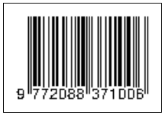Pengembangan True Random Number Generator berbasis Citra menggunakan Algoritme Kaotis
Dian Arief Risdianto(1*), Bambang Nurcahyo Prastowo(2)
(1) Prodi Elektronika dan Instrumentasi, DIKE, FMIPA UGM, Yogyakarta
(2) Departemen Ilmu Komputer dan Elektronika, FMIPA UGM, Yogyakarta
(*) Corresponding Author
Abstract
Keywords
Full Text:
PDFReferences
[1] M. Siswanto and B. Rudiyanto, “Designing of Quantum Random Number Generator ( QRNG ) for Security Application,” in International Conference on Science in Information Technology (ICSITech), 2017, pp. 273–277 [Online]. Available: https://ieeexplore.ieee.org/document/8257124/. [Accessed: 16-June-2018]
[2] J. Morosi, M. Guasoni, A. Akrout, and J. Fatome, “Random Bit Generation through Polarization Chaos in Nonlinear Optical Fibers,” in Conference on Lasers and Electro-Optics Europe & European Quantum Electronics Conference (CLEO/Europe-EQEC), 2017. [Online]. Available: https://ieeexplore.ieee.org/document/8086464/. [Accessed: 18-June-2018]
[3] L. Gnoli, M. Bollo, M. Vacca, M. Graziano, and G. Di Natale, “True random number generator based on nanomagnets,” in IEEE Nanotechnology Materials and Devices Conference (NMDC), 2016. [Online]. Available: https://ieeexplore.ieee.org/document/7777089/. [Accessed: 18-June-2018]
[4] R. Li, “A True Random Number Generator algorithm from digital camera image noise for varying lighting conditions,” in Proceedings of the IEEE SoutheastCon, 2015 [Online]. Available: https://ieeexplore.ieee.org/document/7132901/. [Accessed: 23-Dec-2017]
[5] I. Cicek and G. Dundar, “A chaos based integrated jitter booster circuit for true random number generators,” in European Conference on Circuit Theory and Design (ECCTD), 2013 [Online]. Available: https://ieeexplore.ieee.org/document/6662257/. [Accessed: 23-June-2017]
[6] I. Cicek, A. Pusane, and G. Dundar, “A novel dual entropy core true random number generator,” in International Conference on Electrical and Electronics Engineering (ELECO), 2013, pp. 332–335. [Online]. Available: https://ieeexplore.ieee.org/document/6713856/. [Accessed: 23-June-2018]
[7] I. Cicek, A. E. Pusane, and G. Dundar, “An Integrated Dual Entropy Core True Random Number Generator,” IEEE Trans. Circuits Syst. II Express Briefs, vol. 64, no. 3, pp. 329–333, 2017. [Online]. Available: https://ieeexplore.ieee.org/document/7469345/. [Accessed: 23-June-2017]
[8] İ. Koyuncu, A. T. Özcerit, İ. Pehlivan, and E. Avaroğlu, “Design and implementation of chaos based true random number generator on FPGA,” in 22nd Signal Processing and Communications Applications Conference (SIU), 2014, pp. 236–239. [Online]. Available: https://ieeexplore.ieee.org/document/6830209/. [Accessed: 23-May-2018]
[9] P. Kumar, S. Agarwal, and S. Shivani, “Halftone Visual Cryptography with Pixel Expansion,” Int. J. Inf. Comput. Technol., vol. 4, no. 14, pp. 1419–1427, 2014. [Online]. Available: https://www.ripublication.com/irph/ijict_spl/ijictv4n14spl_10.pdf. [Accessed: 25-May-2018]
[10] P. M. Nikate and I. I. Mujavar, “Performance Evaluation of Floyd Steinberg Halftoning and Jarvis Haltoning Algorithms in Visual Cryptography,” Int. J. Innov. Eng. Technol., vol. 5, no. 1, pp. 336–342, 2015 [Online]. Available: ijiet.com/wp-content/uploads/2015/03/46.pdf. [Accessed: 26-May-2018]
[11] L. Skanderova and A. Řehoř, “Comparison of Pseudorandom Numbers Generators and Chaotic Numbers Generators used in Differential Evolution,” in Nostradamus 2014: Prediction, Modeling and Analysis of Complex Systems, 2014, pp. 111–121. [Online]. Available: https://link.springer.com/chapter/10.1007/978-3-319-07401-6_11. [Accessed: 30-May-2018]
[12] Y. Wu, Z. Hua, and Y. Zhou, “n-Dimensional Discrete Cat Map Generation Using Laplace Expansions,” IEEE Trans. Cybern., vol. 46, no. 11, pp. 2622–2633, 2016 [Online]. Available: https://ieeexplore.ieee.org/document/7302020/. [Accessed: 28-May-2018]
[13] E. Avaroglu, “Pseudorandom number generator based on Arnold cat map and statistical analysis,” Turkish J. Electr. Eng. Comput. Sci., vol. 25, no. 1, pp. 633–643, 2017 [Online]. Available: http://journals.tubitak.gov.tr/elektrik/issues/elk-17-25-1/elk-25-1-48-1507-253.pdf. [Accessed: 1-June-2018]
[14] P. Singh, B. Raman, and M. Misra, “A (n, n) threshold non-expansible XOR based visual cryptography with unique meaningful shares,” Signal Processing, vol. 142, pp. 301–319, 2018 [Online]. Available: https://annals-csis.org/Volume_10/drp/47.html. [Accessed: 2-June-2018]
[15] L. Zhao, X. Liao, D. Xiao, T. Xiang, Q. Zhou, and S. Duan, “True random number generation from mobile telephone photo based on chaotic cryptography,” Chaos, Solitons & Fractals, vol. 42, no. 3, pp. 1692–1699, 2009 [Online]. Available: https://www.sciencedirect.com/science/article/pii/S0960077909001866. [Accessed: 3-Desember-2017]
[16] B. Mondal, N. Biswas, and T. Mandal, “A Comparative study on Cryptographic Image Scrambling,” in Proceedings of the Second International Conference on Research in Intelligent and Computing in Engineering, 2017, vol. 10, pp. 261–268 [Online]. Available: https://annals-csis.org/Volume_10/drp/47.html. [Accessed: 20-June-2018]
Article Metrics
Refbacks
- There are currently no refbacks.
Copyright (c) 2020 IJEIS (Indonesian Journal of Electronics and Instrumentation Systems)

This work is licensed under a Creative Commons Attribution-ShareAlike 4.0 International License.
View My Stats1







